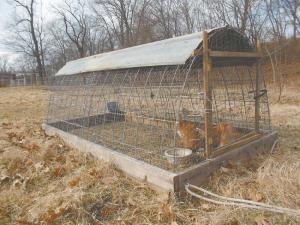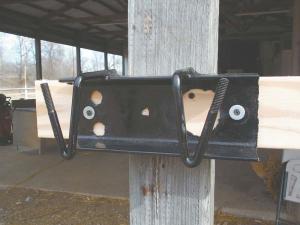Pastured Rabbits Butchered With Farm-Built Gadgets
My husband, Caleb Howerton of Norwood, Mo., decided recently to start raising rabbits to offset his family’s meat costs and to provide future income. His meat rabbit breed of choice was Broken New Zealand Reds. “I chose Broken New Zealand Reds over a solid colored meat breed because the red and white markings make it easier to tell potential breeders apart from the rest,” Caleb said. “Plus, New Zealand rabbits in general have one of the best meat to bone ratios of any meat breed.”
Instead of raising rabbits conventionally in cages, Caleb decided to put them on pasture in portable pens like poultry. The pens have wire mesh floors so they can’t tunnel out and can be moved each day to fresh grass. The 4 by 8-ft. “rabbit tractor” is built from 2 by 6 boards, a cattle panel, 2 by 4 welded wire, a sheet of tin and chicken wire. An 8-ft. sheet of tin was used to create a roof for shade and weather protection. Lastly, some small boards, hinges and extra wire were used to fashion a door, and large eye screws were attached to the front of the frame along with a rope for ease of pulling.
After 12 weeks on pasture, the fryer rabbits are processed with the help of some tools created from some odds and ends found around the farm. A “rabbit wringer” is used to dislocate the spinal cord of the rabbit when processing. Rabbits are butchered by first breaking the neck of the animal. A wringer must be sturdy enough to get the job done quickly and efficiently. Howerton’s rabbit wringer is made from 1 ½-in. angle iron and a short piece of rebar. Using a cutting torch, the rebar was heated and bent into a notch shape that would fit the rabbit’s head, and then welded to the angle iron. Two holes were drilled into the angle iron so that the wringer could be screwed to a sturdy board or post. Once the metal cooled, the wringer was spray painted black to prevent rust.
Once the rabbit is ready to be dressed, a rabbit hanger is used to hang the rabbit by the feet so that it can easily be skinned and cleaned. Caleb built his hangers using 1 ½-in. angle iron, and long bolts. Two bolts were used for each hanger – just like with the wringer, the bolts were heated with a cutting torch, and each one was bent into a V shape before being welded onto the angle iron. Holes in the angle iron allow the hanger to be attached wherever it’s needed. The rabbit hanger was also spray painted black to keep the tool from rusting.
Contact: FARM SHOW Followup, Caleb Howerton, 5805 Curtner Rd., Norwood, Mo. 65717.

Click here to download page story appeared in.
Click here to read entire issue
Pastured Rabbits Butchered With Farm-Built Gadgets LIVESTOCK Exotic Animals My husband Caleb Howerton of Norwood Mo decided recently to start raising rabbits to offset his family’s meat costs and to provide future income His meat rabbit breed of choice was Broken New Zealand Reds “I chose Broken New Zealand Reds over a solid colored meat breed because the red and white markings make it easier to tell potential breeders apart from the rest ” Caleb said “Plus New Zealand rabbits in general have one of the best meat to bone ratios of any meat breed ” Instead of raising rabbits conventionally in cages Caleb decided to put them on pasture in portable pens like poultry The pens have wire mesh floors so they can’t tunnel out and can be moved each day to fresh grass The 4 by 8-ft “rabbit tractor” is built from 2 by 6 boards a cattle panel 2 by 4 welded wire a sheet of tin and chicken wire An 8-ft sheet of tin was used to create a roof for shade and weather protection Lastly some small boards hinges and extra wire were used to fashion a door and large eye screws were attached to the front of the frame along with a rope for ease of pulling After 12 weeks on pasture the fryer rabbits are processed with the help of some tools created from some odds and ends found around the farm A “rabbit wringer” is used to dislocate the spinal cord of the rabbit when processing Rabbits are butchered by first breaking the neck of the animal A wringer must be sturdy enough to get the job done quickly and efficiently Howerton’s rabbit wringer is made from 1 ½-in angle iron and a short piece of rebar Using a cutting torch the rebar was heated and bent into a notch shape that would fit the rabbit’s head and then welded to the angle iron Two holes were drilled into the angle iron so that the wringer could be screwed to a sturdy board or post Once the metal cooled the wringer was spray painted black to prevent rust Once the rabbit is ready to be dressed a rabbit hanger is used to hang the rabbit by the feet so that it can easily be skinned and cleaned Caleb built his hangers using 1 ½-in angle iron and long bolts Two bolts were used for each hanger – just like with the wringer the bolts were heated with a cutting torch and each one was bent into a V shape before being welded onto the angle iron Holes in the angle iron allow the hanger to be attached wherever it’s needed The rabbit hanger was also spray painted black to keep the tool from rusting Contact: FARM SHOW Followup Caleb Howerton 5805 Curtner Rd Norwood Mo 65717
To read the rest of this story, download this issue below or click
here to register with your account number.









